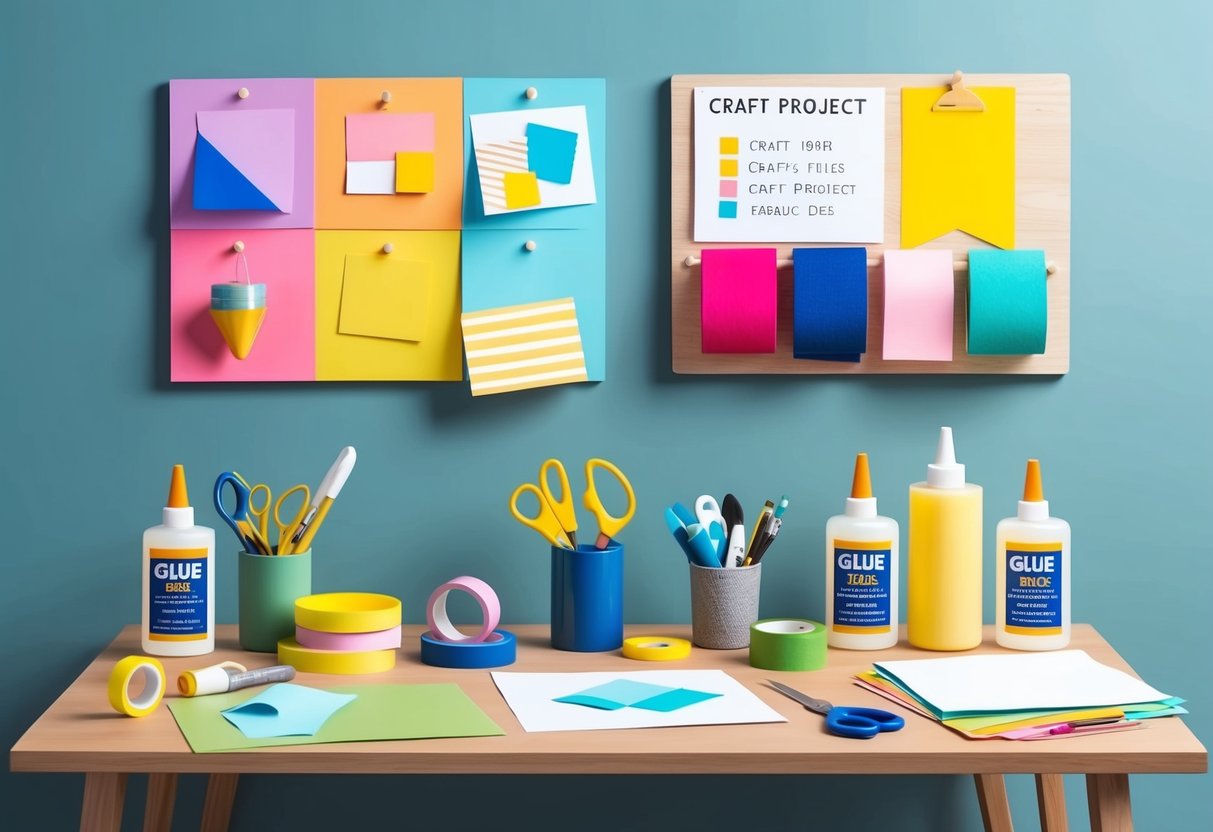
Choosing the right glue for each craft project is crucial because different materials require specific adhesives to achieve the strongest bond. The best results in crafting come from understanding which adhesive works for glass, paper, fabric, wood, or metal, and knowing when to choose PVA, epoxy, hot glue, or specialty options.
Tackling DIY or professional crafts without proper glue can lead to frustrating results, wasted supplies, and projects that simply don’t last.
Crafters can explore a variety of glue types, including removable, waterproof, liquid, and clear adhesives, to suit their needs. With options ranging from basic craft glue to industrial-strength adhesives, selecting the right one ensures durability and a clean finish on every project.
A careful choice can make a significant difference, whether the goal is flexibility, quick drying time, or invisible seams.
By learning the essential guide to craft glues and their specific uses, crafters can improve efficiency and confidence in their projects.
Detailed comparisons and expert insights from guides like the Essential Guide to Craft Glues and the Ultimate Guide to Adhesives for Every Project can help anyone, from beginners to seasoned hobbyists, confidently select the perfect glue for any material or technique.
Understanding Adhesive Fundamentals
Adhesives play a crucial role in a variety of craft projects by joining materials securely. Knowing the differences between adhesive types, their unique properties, and how they impact bond strength is essential for selecting the most effective glue for each application.
What Is an Adhesive?
An adhesive is a substance formulated to bind materials together by creating a strong bond at the surfaces. Adhesives can be synthetic, like epoxy resins and cyanoacrylate, or natural, such as starch paste or animal glues.
Most craft adhesives are formulated to work with materials like paper, fabric, wood, metal, glass, and plastics. They rely on either chemical or physical interactions to hold substrates together.
Adhesive performance is influenced by factors such as surface preparation, curing time, and environmental conditions. Choosing the right adhesive type can prevent weak bonds and project failures.
Unique Properties of Different Glues
Each adhesive type offers distinct properties that make it suitable for certain materials or situations. For example, PVA glue (polyvinyl acetate) is ideal for porous materials like wood and paper, while epoxy resins deliver high strength and resistance on metals and glass.
Some glues, such as hot glue and contact cement, provide quick initial bonds and flexibility after curing. Others, like cyanoacrylate, offer instant adhesion and rigid bonds but may become brittle on flexible surfaces.
Understanding the solvent type, drying method (air-dry, heat-set, or chemical cure), and resistance to factors like moisture or heat is key to choosing the right adhesive for a specific craft project.
Glues also vary in transparency, texture, and ease of clean-up.
Bond Strength and Durability
Bond strength refers to how well an adhesive holds two materials together under pressure or tension. Durable adhesives form bonds that resist stress, environmental changes, and repeated use—critical for both decorative and functional craft items.
Strong bonds are typically achieved when the adhesive matches the material type and application. Epoxy and polyurethane adhesives are known for strong, durable bonds on challenging surfaces.
In contrast, a temporary adhesive like repositionable spray is designed for projects that may need adjustments or short-term holds.
Longevity depends on the resistance of the bond to water, UV light, temperature fluctuations, and mechanical wear.
Selecting adhesives based on both initial bond strength and long-term durability helps prevent project issues and ensures lasting results.
Types of Glue Explained
Different craft projects require specific adhesives to achieve the best results. Application surfaces, drying times, and bonding strength vary widely between products, so choosing the right type of glue is essential for a lasting finish.
White Glue
White glue, also known as PVA (polyvinyl acetate) glue, is a staple for paper-based crafts and lightweight materials. It dries clear, is easy to clean up with water, and is safe for all ages.
PVA is ideal for school projects, paper collages, scrapbooking, and porous materials like cardboard and wood veneer. White glue bonds well with most porous surfaces but is not suited for plastic, metal, or non-porous materials.
It should be clamped or pressed for the strongest bond and allowed to fully cure for several hours. This product remains flexible after drying, which helps prevent cracking.
For more information about the variety of popular PVA glues and other crafting adhesives, see this overview from Tonic Studios.
Super Glue and Cyanoacrylate Adhesive
Super glue, or cyanoacrylate adhesive, is best known for forming fast, strong bonds on non-porous materials like plastics, metals, ceramics, and glass. Unlike PVA, cyanoacrylate sets within seconds to a minute, making it extremely convenient for small repairs and quick fixes.
Care is needed, since super glue bonds skin and fingers instantly. The finished joint is rigid and not suited to flexible or expanding materials.
It also works poorly on surfaces exposed to moisture or heavy stress. To achieve a reliable bond, surfaces should be clean and dry before application.
Cyanoacrylate is not ideal for foam, rubber, or items that require repositioning after gluing.
Wood Glue
Wood glue is formulated specifically for woodworking and carpentry projects, offering strong adhesion to wooden surfaces and fibers. Most wood glues are yellow or tan in color, but they dry clear or slightly amber, blending into most wood finishes.
This adhesive penetrates wood pores and creates a bond that is often stronger than the wood itself. Its formulation resists moisture and heat, making it suitable for furniture and structural woodwork.
Some wood glues are labeled for interior or exterior use; always choose accordingly. Clamping is recommended during the drying phase, which typically lasts 20 to 30 minutes for an initial tack and up to 24 hours for maximum strength.
Glue Stick and Washable Glue
Glue sticks and washable glues are designed for convenience and mess-free application, especially in classrooms and for children’s crafts. Glue sticks come in a solid, twist-up format that glides smoothly over paper and lightweight card for instant, even coverage.
Washable formulas clean up easily with soap and water, making them a favorite for parents and teachers. These adhesives are non-toxic and suitable for paper, photos, labels, and projects where repositioning may be necessary before drying.
They provide enough hold for light crafts but are not intended for heavy or durable applications.
For a breakdown of common glue stick types and when to use washable adhesives, you can refer to crafting guides on adhesive selection.



